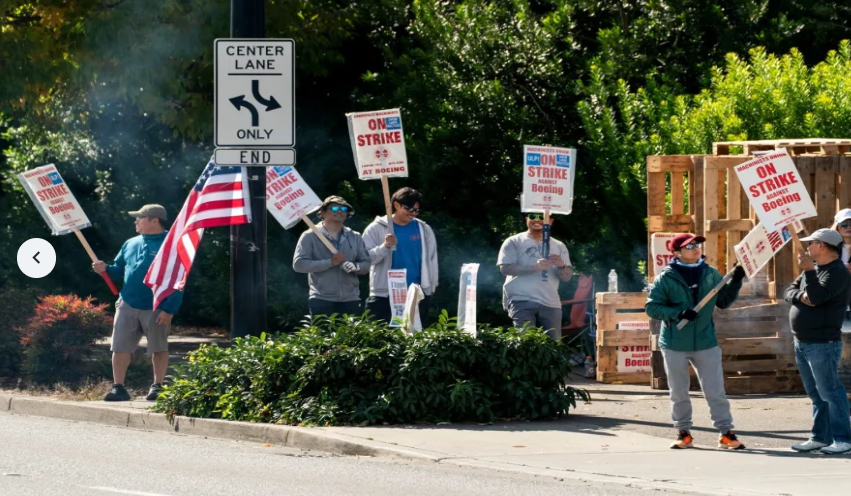Two weeks after Boeing Co. tried and failed to end a strike with the brash move of a direct offer to workers, the planemaker and its largest union are taking another stab at a more conventional pattern of consultation and shuttle diplomacy to end the stalemate.
A federal mediator has summoned negotiators for Boeing and IAM District 751 back to a Seattle hotel on Monday. It’s the first inkling of movement toward a compromise that might yield a third contract offer — and the possibility of ending the three-week old strike that’s driving up costs for the manufacturer and its 33,000 striking workers alike.
Just how and when the dispute might be resolved remains uncertain. Since the last direct meeting on Sept. 27, there’s been little direct contact between the two sides, which remain deeply divided in particular over a union demand to reinstate a defined benefit pension plan. Last week, workers lost access to company-backed health-care benefits, while each day of strike costs Boeing an estimated $100 million in lost sales.
As the strike enters its fourth week, hopes are fading for a speedy resolution even after dockworkers at US East and Gulf coast ports quickly ended their walkout last week with an agreement that would boost wages by 61.5% over six years. Boeing’s last unsuccessful overture included a 30% general wage increase.
Bridging the differences will require delicate maneuvering by Boeing and local leaders of the International Association of Machinists and Aerospace Workers, who’ve both made blunders that angered rank-and-file workers. The timing of a resolution will ultimately depend on not just negotiators, but hourly workers reveling in labor’s resurgence and the opportunity to reset their standing after years of stagnant wages and a much-maligned previous contract that stripped away pensions.
“I’d say morale is still high,” said Nico Savranakis, 28, who works as a team lead mechanic at Boeing. “It’s great to see everybody standing together and unified.”
But the economic pain is starting to set in for both sides. Union members haven’t been paid by Boeing since Sept. 19, and they face greater out-of-pocket costs after the health benefits ended.
With its jet deliveries slowed to a trickle by the strike, Boeing’s already difficult financial situation is worsening by the day — with credit-rating companies anxiously watching over the strike’s duration as they consider cutting the credit rating to junk.
“From the union point of view, it’s still early days and there’s lots of enthusiasm in the trenches,” said Leon Grunberg, a sociology professor who’s studied Boeing’s labor relations since the 1990s.
A Boeing tactic intended to quickly snuff out the strike backfired two weeks ago when the company bypassed collective bargaining and presented a 30% pay raise directly to workers and sought to pack in more punch with an ultimatum to respond. Boeing quickly retreated after union leaders refused to schedule a vote. If anything, the maneuver had the effect of solidifying support for IAM District 751 President Jon Holden.
For union members, seeing Boeing hike its wage offer to 30% from 25% only a week-and-a-half into the strike “has union members believing they’ve got the upper hand,” Cai von Rumohr, analyst with TD Cowen, wrote in an Oct. 1 report.
After 96% of members voted to strike and rejected a deal supported by the International Association of Machinists and Aerospace Workers, union negotiators have taken a hard line at the negotiating table. They’ve reverted to two of their original demands from when talks began in March: demanding a 40% pay raises and reinstating pensions.
Boeing is unlikely to yield on the pension plan, Grunberg said, given its dire financial situation and with other contract talks looming with Machinists in St. Louis and Seattle engineers. The company has been in a tight financial spot since an near-catastrophic accident in January forced it to cut back production.
That move, aimed to improve manufacturing quality, has led to a cash drain, which is set to continue in the third quarter. In his bi-weekly message to employees on Oct. 4, Chief Executive Officer Kelly Ortbert said a resolution with the IAM union “stands as a priority for me.”
“I am confident that we will get through this period and come together as one team,” Ortberg, who took over early in August, said in the memo.
Striking workers, meanwhile, have found ways to stretch their resources as they dig in for a potentially longer-term battle. John Son, a 42 year-old quality inspector who has been with Boeing for 10 years, said he can get by if the strike drags into November. He’s got the savings, and he’s started making his own t-shirts to sell online to bring in some extra money.
“I miss going, I miss working, I do miss my paycheck,” Son said in an interview. He’s striking for better pay to make up for the wages he lost under the previous contract’s paltry increases. He’d consider a lower pay raise if it meant better retiree benefits.
“We want to keep our bonus, we want a little bit more money and possibly a pension, but if not, you know, we’ll see what we get,” he said.




